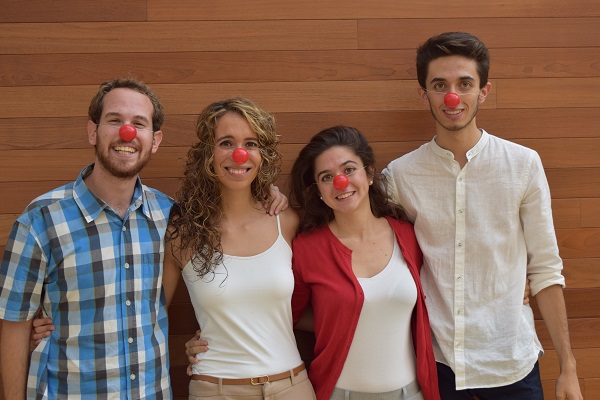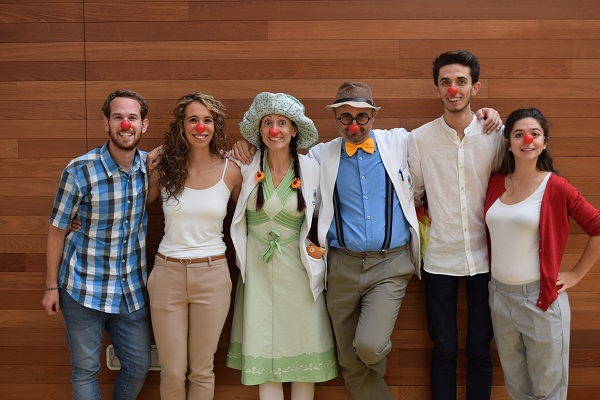“We have witnessed how hospitalized children stop feeling frightened and start smiling again”
“We have witnessed how hospitalized children stop feeling frightened and start smiling again”

Mireia Rom and Roger Cuartielles are UPF alumni of Journalism and students of Humanities at the University. Together with Glòria Macià, a graduate in Biomedical Engineering (UPF), and Sergi Macià, a student of Electronic Engineering (UPC), they are promoting the “Un Gomet Vermell”project.
This charitable crowdfunded campaign to collect funds forPallapupas, an NGO that helps fight hospitalized children’s loneliness and fearthrough humour, was the winner of the first edition of the award for best HackLab project, to the amount of 800 euros, and which also gave mentions to the projects “GameSquare” and “Pompeu.cat”.
HackLab is a co-creation workshop open to the entire UPF community, located on the second floor of the Library/CRAI of the Poblenou campus. It aims to become a space to promote, encourage and facilitate self-learning, the exchange of knowledge and ideas, and collaboration around issues such as technology, communication or the digital arts.
Within the framework of the project PlaCLIK 2016/2017“IMAX: Interactions beyond subjects and classrooms to increase student success”, awarded to the Teaching Quality and Innovation Support Units (USQUIDs), HackLab is coordinated by professor Davinia Hernández Leo and enjoys the participation of the Centre for Learning Innovation and Knowledge (CLIK).
—How did the idea of creating “Un Gomet Vermell” come up?
(Mireia) “Un Gomet Vermell” came from the desire of the four members of the team to carry out a charitable project together. Then the idea came up of creating a crowdfunded campaign to help promote children’s entertainment in hospitals. We are convinced that the optimism transmitted by hospital clowns is vital in fighting a disease or when hospitalized, especially when you’re a child. At the moment, children’s entertainment doesn’t get to all hospitals in Catalonia, and for this reason the campaign aims to raise funds so that these projects can continue working and, if the amount received permits, to extend it to more hospitals. In addition, when one of the members of the team, Glòria Macià, was little, she received a visit from a hospital clowns one Christmas she was admitted, so the project also represents a way of thanking the people like the ones that made her laugh for the job they do.
—Journalists, engineers, humanists, etc. You are an interdisciplinary team. What areas do you cover with this variety of profiles?
(Roger) From the outset, as a team, it was clear to us that to carry out the project and make it known we had to provide answers to two main areas: the design and programming of the website, and the communication of the project. So, having engineering profiles within the team has been very useful for designing a good website, with several features to make the project more understandable and accessible to everyone who wants to contribute to it. With regard to the profile of journalist and communicator, this has been useful in filling the web with contents and defining a communication plan to explain the project. In this way, through the synergies between the different disciplines, we believe that “Un Gomet Vermell” can become more enriching and better known, since the essential aspects of the campaign are fully covered.
—What has the HackLab environment meant for you and how has it made your task easier?
(M) The HackLab prize has helped us, above all, to make “Un Gomet Vermell” a far more ambitious project. On the one hand, the funding has made it possible to invest in resources that we might otherwise not have afforded or we would have had to pay for ourselves, such as the printing of an illustrated tale to hand out to hospitalized children and also the cost of the website. Also, HackLab has given us a great boost at the start of the campaign and has made us known. Thus, we’ve used the facilities and the audiovisual equipment of the Library/CRAI on the Poblenou campus, which has been of great help, because otherwise we would have had to resort to a professional company and this would have been an extra cost for the campaign.
—How is it you thought of Pallapupas and what link do you have with this NGO?
(R) We thought about collaborating with Pallapupas because we knew that it is one of the reference organizations concerning children’s entertainment in hospitals. We think they do a great job, and for this reason we wanted to contribute our grain of rice so that this vital task for hospitalized children could reach even more children and centres.
—What does your project consist of? Are you looking to interact with people?
(M) The project has four main axes. First, raising money through donations from individuals, companies and organizations. Secondly, we have made two videos that will help us to make the project known: one shows what a visit by a pair of clowns to a hospital is like, and the other delves into how children’s entertainment projects contribute to making hospitals more human through interviews with health professionals, clowns, families and children. Thirdly, we have prepared an illustrated tale thanks to the collaboration of an illustrator, Jeenal Patel, that we’re going to hand out to children in hospitals and we will also post on the website so that schools and organizations will be able to download and use it as educational material. Finally, as we are especially seeking interaction with the boys and girls, we have created the “De Gomet a Gomet” community. On the website we will post several videos of children and young people in hospital who tell us their story, and the idea is that other boys and girls record themselves giving them a message of support. We want to make it an interactive campaign both with the people who send us their donations and, above all, between the boys and girls themselves.
—Which contents are ready and which are still missing?
(R) At the moment we have the website ready, which allows knowing about the project and finding out how you can contribute to it. We also have one of the two audiovisuals prepared, which shows what the visit by a pair of hospital clowns to a hospitalized child is like, and the illustrated booklet. What is left to do is to edit the second video, which highlights how essential it is for hospitals to have children’s entertainment projects. We also still have to outline other activities that contribute to the promotion of the project, for example, the videos in which the hospitalized children explain who they are and what they like doing. On 26 October we will be participating at the UPF Solidària Fair to make ourselves known and to explain the project, and for Christmas, another activity we have devised is some solidarity postcards that schools collaborating with the project will make for the children in hospital.
—Do you plan to make your initiative known among a children’s audience?
(M) Our intention is for schools, youth centres and children’s groups that so wishcan join the project using the illustrated tale as educational material and encouraging boys and girls to record a video for another hospitalized child. When we discussed how to direct the campaign it was very clear to us that we wanted it to be a campaign by children for children. Although only adults can make a financial donation, children have the ability to become aware of other realities and to get actively involved in charity projects. We want children to be aware that they can also do things to change the world and to promote contact between hospitalized children and other children from all over the country.
 —What system will you use so that people can make donations?
—What system will you use so that people can make donations?
(R) The system we will use to manage the donations will be the charity crowdfunding platform elmeugradesorra.org. In this way, we will be able to manage donations efficiently and transparently in a widget integrated into the web.
-Will you will be very strict with the justification of income?
(M) Absolutely. We will publish graphs and tables on the website for those collaborating to know the cost of each animation activity we want to fund, the percentage of money assigned to each task, and that the only money for us will be to offset the costs of the campaign.
—How will the profits you make reach Pallapupas?
(R) Our initial idea is to get 30,000 euros, which is what it would cost to open an animation service at a new hospital and guarantee that 2,000 hospitalized children can receive some entertainment. However, if in the end the figure were lower, this would be used to fund various entertainment activities offered by Pallapupas such as visits by clowns to hospitals, workshops, social theatre workshops for people with a mental disorder, and training for health professionals in order to humanize the medical processes.
—Does your project have a duration in time? When can people start making donations?
(M) As of today you can start to make donations. Our idea is for the campaign to last approximately until June, coinciding with the end of the 2017-2018 academic year.
—In which geographical area and at which hospitals?
(R) The geographical scope of the project focuses on Catalonia and its hospitals. So far, we have made contact with Hospital del Mar and Sant Joan de Déu, but later we expect contact more centres. Our idea is to reach as many public hospitals in Catalonia as possible.
—Is there a lack of entertainment for children in hospitals? How do the hospitalized children react to the humour of Pallapupas?
(M) There are hospitals in Catalonia that, due to a lack of resources, have no children’s entertainment service. For example, Pallapupas works with eleven hospitals, and often one of the challenges concerning funding is to be able to keep these visits going. The reaction of the children is extraordinary. At the visits we have attended, and also commenting on them with health professionals,we have witnessed how hospitalized children stop feeling frightened and reticent and start feeling more at ease, relaxed and get that characteristic children’s smile back. While it is true that some children prefer to be alone because they are afraid or want to return home, most are infected by the positivism and energy given off by the clowns and immediately join in with their game. After all, these visits involve forgetting for a moment that they are in an unfamiliar environment, not the one they’re used to, and they feel more supported. During the visits, the hospital goes from being a cold place where there is pain to a place where having fun is allowed: the child becomes less of a patient and more of a child.
—What are your plans for your future careers?
(R) The four of us have very different profiles and we would like to devote ourselves to what we have studied. However, we can say that we have a common denominator, which is to continue collaborating with supportive initiatives involving the public to contribute to social transformation and make the world a more friendly and human place.
